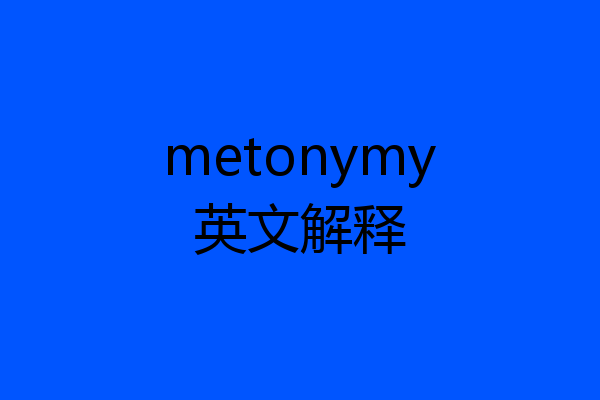
0度空间的鱼
借代 [词典] metonymy; [例句]谈谈借代的定义、归类与运用原则&借代辞格的多角度研究之一Definition, Classification and Principle of Application of Metonymy& One of Metonymy Studies from Different Perspectives


thomas0488
Metonymy 转喻A figure of speech in which one word or phrase is substituted for another with which it is closely associated, as in the use of “ Washington” for “the United States government” or of “the sword” for “military power”. The kettle is boiling. (water in the kettle) He took to the bottle.他爱上了喝酒。 (wine in the bottle) I’m reading Lu Xun. ( Lu Xun’s works) He’s listening to Beethoven. (Beethoven’s works) He is booked out for the whole season.他这个季演出的票全订出去了 。 (the tickets for his concerts)When she entered high school, she would wear a wardrobe that no one else would be able to match.当她上中学时,她所穿的衣服任何一个人都没法比。They will resort to the sword if the negotiation does no work. She is the first violin in the band.她是乐队中的第一小提琴手。Synecdoche 提喻A figure of speech in which a part is used for the whole, the whole for a part, the specific for the general, the general for the specific, or the material for the thing from which it is made. Young people should have more respect for gray hairs. He saw some new faces in the classroom. A fleet of ten sails \ To earn one’s bread \ To count heads Many hands provide great strength. The poor man had twelve mouths to feed. Lend me your ears. ( give me your attention.)Both are figures of speech used in rhetoric. They’re not the same thing, though metonymy is often interpreted so widely that synecdoche can be regarded as a special case of it.As for Synecdoche, You use this when you speak of a part of something but mean the whole thing. When Patrick O’Brian has Captain Jack Aubrey tell his first lieutenant(陆军中尉) to “let the hands go to dinner” he’s employing synecdoche, because he’s using a part (the hand) for the whole man. You can also reverse the whole and the part, so using a word for something when you only mean part of it. This often comes up in sport: a commentator might say that “The West Indies has lost to England” when he means that the West Indian team has lost to the English one. America is often used as synecdoche in this second sense, as the word refers to the whole continent but is frequently applied to a part of it, the USA.Metonymy is similar, but uses something more generally or loosely associated with a concept to stand in for it. When Americans speak of the Oval Office(美国总统办公室), for example, they are really referring to the activity within it, the position or function of the President. It’s a linked term, and so a metonym. British writers refer similarly to the Crown(王冠), when they’re really discussing the powers, authority and responsibilities of the monarchy(君主政体), which is symbolized by the crown. The difference between synecdoche and metonymy is that in metonymy the word you employ is linked to the concept you are really talking about, but isn’t actually a part of it. Another example is the turf(草皮) for horse racing. But the distinction isn’t always obvious and often can’t be rigorously applied, and many people use metonymy to mean both.

兜兜里有糖布布
积极修辞(Active Rhetoric Techniques) 它主要指那些有相对固定格式的修辞性写作技巧。常见分类如下:词义修辞格 (Lexical Stylistic Devices) metaphor(比喻), metonymy(借代), personification(拟人), irony(反语), hyperbole(夸张), understatement(低调), euphemism(委婉语), contrast(对照), oxymoron(矛盾修辞法), transferred epithet(移就), pun(双关), syllepsis(异叙), zeugma(粘连), parody(仿拟), paradox(隽语)结构修辞格 (Syntactical Stylistic Devices) repetition(反复), catchword repetition(联珠), chiasmus(回文), parallelism(平行结构), antithesis(反对), rhetoric question(设问), anticlimax(突降)音韵修辞格 (Phonetic Stylistic Devices) alliteration(头韵), onomatopoeia(拟声)1. Parody(仿拟)如:Clearly, when it comes to marriage, practicing beforehand doesn’t make perfect. 可以译成:显然,在婚姻问题上,婚前同居并不能令婚姻生活趋于完美。2、Syllepsis(异叙)如:He first put a club in my hand when I was about ten. I threw a lot of tantrums in the upland hills of North Carolina, and clubs too. I was in such a rush to be good that he would urge me to “relax and enjoy the round. The game ends far too soon.” I didn’t have a clue what he meant. 试译:他第一次把高尔夫球棒放在我手里的时候,我大概十岁。在北卡罗来纳州的山中,我一次次发脾气,一次次把球棒扔掉。我急于求成,老爸总是劝我“放松点,慢慢打,比赛结束得太快了。”3. metonymy(借代)借代一般可以保留原文的修辞方式,不会引起误会,同时让译文多了一份词趣。如:So, during any five-week shape-up, focus more on the tape measure than on the bathroom scale. 译文A:因此,在此五周的减肥期内,要更多地注重自己的腰围,而不是自己的体重。译文B:因此,在此五周的减肥期内,把注意力放在量腰围的卷尺上,而不是放在浴室的磅秤上。 4. pun(双关)有许多看似无法在译文中挽留的原文形式的神韵和风采在译文中却得以挽留。如:First gentleman: Thou art always figuring disease in me, but thou art full of error, I am sound. Lucio: Nay, not as one would say, healthy; but so sound as things that are hollow; impiety has made a feast of thee. (整个对话之谐趣尽系双关词汇sound。)试译:绅士甲:你总以为我有那种病,其实你大错特错,我的身体响当当的。路奇奥:响当当的,可并不结实,就像空心的东西那样响当当的,你的骨头都空了,好色的毛病把你掏空了。 5. alliteration(头韵)英语辞格押头韵的手法历来被认为是不可译的,但是,面对alliteration,并不意味译者就无所作为。如下的两段译文就做了成功的尝试。如:Change is part of life and the making of character, hon. When the things happen that you do not like, you have two choices: You get bitter or better. 试译:变化是生活的一部分,而且也塑造了人的意志品德,亲爱的。当你不喜欢的事情发生了,你有两种选择:要么痛苦不堪;要么痛快达观。6. metaphor(比喻)这个metaphor并非狭隘意义上的把A比作B的不使用比喻词(如as, like, as if等)的暗喻,而是广义上的英语词汇的比喻义。换言之,也就是英语词汇denotation(本义)之外的connotation(转义)。Peter Newmark在A Textbook of Translation中把英语中的比喻分成四类,令人耳目一新 have suggested elsewhere that there are four types of metaphor: fossilized, stock, recently created and original. 第一类:有学生在作文中写出如下句子:In the middle of the picnic, it started to rain cats and dogs, and everybody got soaked. 该句子被改为:While we were busy eating a picnic, a storm cloud suddenly appeared and everybody got soaked. 在A Dictionary of American Idioms中,写道:rain cats and dogs: To rain very hard; come down in torrents------A cliché. 美国朋友说: If you use this metaphor, I will doubt if you are my grandfather’s uncle! 第二类:stock(常用的)这是指已被收入词典,但并不属于cliché范畴的比喻。如:flood一词的用法。She was in a flood of tears. (她泪流如注。) The corridors were flooded with girls. (走廊里挤满了女孩子。) Strawberries flooded the market and prices dropped down. (草莓充斥市场,价格下跌。) 第三类的标准应该是:至少目前商未被收入词典,同时又让人接受,并感到新意扑面。如在一篇名为Rescue of A Newborn 中有三个句子:A. I focused on a small blob in the mud amid the columns of legs and trunks. B. I suddenly came upon a wall of feeding elephants. C. …grabbed their lost baby and tugged her gently into a stockade of legs. 第四类:original这种比喻并非随处可见,唾手可得。它是灵感思维的产物。这种比喻在词典上无踪影可觅,而且连参照物可能也没有。如:Jeff Rennicke在A Promise of Spring 中开卷段是:Nothing. No tracks but my own are stitched into the dusting of fresh snow, white as birch bark, that fell during the night. No flittering shadows in the trees, not a sliver of bird song in the air. 试译:白茫茫的一片。没有别的什么踪迹,只有我的脚印如细密的针脚印在积雪上。积雪白如桦树皮,是昨夜落下的。在树上没有鸟儿轻捷的身影,在空中也听不到鸟儿一丝的啁啾。

流浪的好吃狗
metonym是借喻的意思。比如我们常说“袁大头”是那种硬币,其实硬币本不是“袁大头”,再比如有人把叫美国政府是“华盛顿”。就是说本体和喻体其实没什么相似的地方,不像把月亮比作玉盘那样有色彩和形状上的相仿,而是通过某种关系,某种习惯,而这样借指。synecdoche,有些时候被人们认为是metonym的分支,但是其实还是有差别的。synecdoche通常是用一部分指代一个整体,或者整体指代部分,总之就是有着从属关系。比如你看见那个人的眼睛是绿色的然后不知道他名字,也懒得知道,就说“碧眼儿”昨天和我去哪里哪里。或者最著名的,小红帽!帽子其实只是她的一个部分,我们用这个独特的部分指代她。